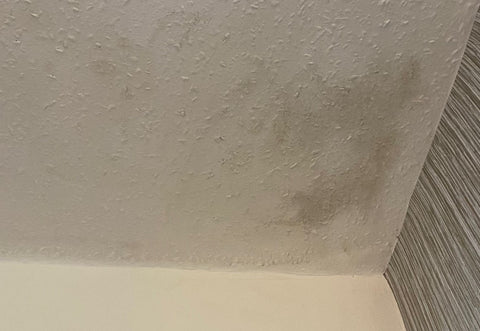Unsightly mould is more than just a cosmetic issue in your home. It poses a real and serious health risk, and can cause permanent damage to your walls and decor if left untreated.
Removing mould from walls permanently can be achieved through a combination of using the right cleaning products and techniques, and eliminating environmental issues which promote mould growth.
We’re going to take a look at how to remove mould from walls in your home, and how to make sure you get rid of it permanently.
How to Remove Mould from Walls Without Damaging Paint
Mould on painted walls needs careful attention to prevent damage to paint. Many types of paint will lift away during cleaning, so it is vital to avoid scrubbing if you don’t want to end up with a patchy finish.
The best mould remover for painted walls is a non toxic natural solution such as white vinegar, or a specialist mould remover which doesn’t use harsh chemicals such as bleach.

This mould developed in a cold corner on the exterior wall of a utility room, where stored items had restricted airflow. Moist air naturally travels to the coolest parts of a room (such as corners) where it condenses, creating ideal conditions for mould to thrive.
Steps to clean mould off painted walls:-
- Do a patch test - ensure your chosen cleaner won’t cause issues with your paint. Apply a small amount to an inconspicuous area first.
- Prepare your space - open windows for ventilation, and make sure you are wearing gloves and eye protection. Even natural cleaners can irritate skin and eyes.
- Apply the cleaner - Spray a solution of mould remover or white vinegar onto the areas affected by mould.
- Wipe gently - use a soft cloth or sponge to remove the mould, do not scrub or apply too much pressure or you may damage your paint.
Our Recommended Natural Mould Cleaner - Auro 412 & 413
Auro Mould Killer is made from completely natural products. It’s ideal for use on walls. To use, simply spray on, leave for a minimum of one hour. Mould can then be brushed away, before lightly cleaning any residue with a soft damp cloth.
See Also: How to remove black mould from wallpaper
How to Get Rid of Mould on Walls Permanently
To ensure mould doesn’t return, you need to make sure that underlying causes are addressed at the same time as cleaning. Removing sources of excess moisture and poor ventilation is key to keeping your walls free of mould.
Here are some things you can do in your home to make sure mould does not return:-
- Ventilation - extractor fans in bathrooms and kitchens can remove moist air. Open windows regularly to stop moist air condensing inside your home.
- Use a dehumidifier - make use of a dehumidifier in problem areas.
- Ensure adequate insulation - a major cause of mould in homes is warm moist air condensing on cold spots on walls and ceilings.
-
Use anti mould paint - using an anti mould paint in areas prone to mould growth can help reduce future issues.
See Also: How to apply anti fungal paint | How to get rid of mould on ceilings
For bathroom mould, ensure you keep the area well ventilated, remove excess moisture from shower cubicles after use, and clean walls and ceilings regularly.
Does Bleach Kill Mould?
Bleach will hide the appearance of mould, but it does not kill spores. Bleach is much less effective than natural alternatives at killing spores inside porous surfaces like plaster or painted walls.
Vinegar or hydrogen peroxide cleaners are much more effective. If need be, diluted bleach can be used for cosmetic purposes if any residue remains after using natural mould cleaners.
Does Anti Mould Paint Work?
Anti mould paint can work very well to keep your room mould free. We recommend using a natural lime based paint to prevent mould growth. This type of paint has a naturally high PH which prevents growth.
We recommend Auro 303 Mould resistant silicate paint, which has a fungicidal and algicidal effect due to its alkalinity. It’s a highly breathable paint which can help reduce moisture build up, particularly in older homes. Auro 327 is also an effective mould resistant paint.
Does White Vinegar Kill Mould?
White vinegar is a highly effective mould killer. It will penetrate surfaces to kill mould spores.
We suggest adding a few drops of eucalyptus oil or tea tree oil to a 50 / 50 solution of water and vinegar. Apply to walls, leave for at least an hour before wiping away any mould residue.
Dangers of Mould in Living Spaces
Exposure to mould can have a profound impact on the health of your family. It can trigger allergies, and worsen asthma and other respiratory issues. Young children and those with weakened immune systems are particularly vulnerable when exposed to mould spores.
Bedroom Mould
Mould in the bedroom is particularly concerning. Prolonged exposure during sleep can have a severe impact on health. Bedrooms can be particularly prone to mould due to the additional moisture created by people sleeping in the room. It’s important to ensure all bedrooms are well ventilated and dehumidifiers should be used if necessary. Ensure you check behind furniture such as drawers and headboards for signs of mould growth.
Health Risks of Mould
Mould can be dangerous to health if allowed to grow unchecked. Here’s a quick overview of different types of mould which may grow in domestic spaces, and their health risks.
- Stachybotrys chartarum - Black or greenish black mould which can thrive in damp areas. Commonly found on plasterboard and wallpaper. This type of mould can have toxic effects causing fatigue, respiratory distress, and even neurological symptoms in severe cases.
- Cladosporium - another black mould which can grow on many surfaces including wood, wallpaper, and carpet. It’s commonly found in high moisture areas such as bathrooms or kitchens. This mould is not as dangerous as Stachybotrys Chartarum, but it can cause issues like sneezing, coughs, runny nose, and itchy eyes.
- Aspergillus - This mould can have a white and powdery appearance before developing into dark fuzzy speckles. It can cause Aspergllosis, which affects the lungs and causes breathing difficulties.
- White Mould - this can appear as fluffy or powdery patches and can be a sign of water ingress. It is not as toxic as black mould, but can cause allergy-like symptoms. If you find white mould in your home, do investigate any internal or external sources of moisture before cleaning.
Understanding the type of mould in your home can help you decide upon the best treatment and whether professional removal is necessary.
Addressing Root Causes of Damp
It’s vital to address the root causes of damp to ensure mould removal is permanent. Otherwise, mould will quickly regrow after cleaning.
Some of the main causes include:-
- Condensation - this is a particular issue in areas prone to high levels of moisture. Common in bathrooms, bedrooms, and kitchens where humid air meets cold surfaces such as exterior walls or poorly insulated ceilings. It can be prevented through the installation of extractor fans, using dehumidifiers, and ensuring these areas are well ventilated.
- Water Ingress - leaky roofs, gutters, or windows can introduce moisture into your home. Cracks in external walls, or issues with exterior masonry can also cause damp. Be aware of any damp patches and try to locate and remedy any issues as soon as possible.
- Non breathable materials - older homes can suffer from damp issues if cement based plasters are used during renovations. If you have an older property with damp issues, check to see what type of plaster has been used on your walls. Using breathable plasters and breathable paints will allow moisture to escape instead of condensing in your home.
- Dirt and Dust - mold feeds on organic materials, so regular dusting and cleaning of walls can remove dirt and dust that might promote growth of mould. A regular deep clean can help walls already identified as problematic.
- Poor air circulation behind furniture - mould can grow behind furniture due to lack of air circulation. Regularly check behind furniture or curtains to identify early signs of mould returning.
Read More: How to prevent mould on walls





